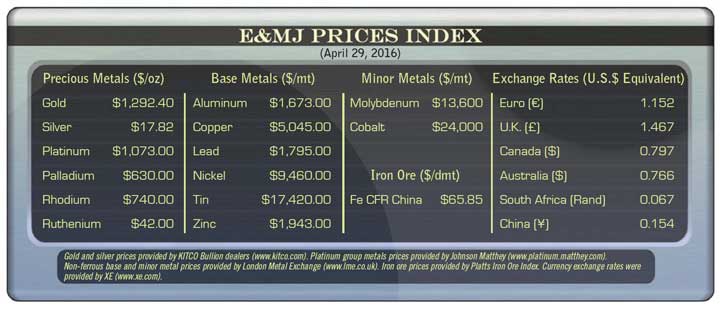At its Spring meeting in Lisbon on April 27, the Standing Committee of the International Lead and Zinc Study Group (ILZSG) received a review of the current outlook for trends in world supply and demand for lead and zinc during 2016.
As far as lead usage, ILZSG anticipates that global demand for refined lead metal will rise by 2% to 10.83 million metric tons (mt) in 2016. In China, increased usage in the automotive and telecommunications sectors will be partially balanced by a reduction in demand in the e-bike market resulting from slower sales growth and increased competition from lithium-ion batteries. European demand is forecast to grow by 3.5%. After falling by 5.2% in 2015, a partial 1% recovery is anticipated in the United States.
Global lead mine output is predicted to increase by 0.5% to 4.58 million mt, mainly as a consequence of a 9.7% rise in China. An expected fall of 6.1% in ex-China production will be primarily due to reductions in Australia resulting from the closure of MMG’s Century mine in August last year and cutbacks announced by Glencore, CBH Resources and Perilya.
After reaching a record 1.03 million mt in 2015, Chinese imports of lead contained in lead concentrates are forecast to fall to just under 900,000 mt in 2016. An anticipated 2.3% rise in global refined lead metal production to 10.90 million mt will be principally influenced by increased output in China and the Republic of Korea where Korea Zinc recently commissioned a new 130,000-mt/y capacity lead plant in Ulsan. The ILZSG now expects a global refined lead metal surplus of 76,000 mt in 2016.
Zinc Outlook for 2016
World usage of refined zinc metal is expected to increase by 3.5% to 14.33 million mt in 2016. This rise will be primarily driven by a further 4.5% increase in China where demand is expected to benefit from continued infrastructure investment. After rising by 3.2% in 2015, usage in Europe is expected to remain stable in 2016. Strong growth of 13.1% is anticipated in the Republic of Korea. Increases are also forecast in India (4.1%), Japan (4.2%) and the United States (3.1%).
A sharp forecast fall in ex-China zinc mine production of 9.4% is due to a combination of mine closures and recently announced production cutbacks. Chinese output, which is reliant on production from a large number of small mines, is forecast to grow by 12.4%. Overall global zinc mine output is expected to fall by 1.4% to 13.27 million mt.
A significant predicted 46% reduction in Australian production is a consequence of the closure of MMG’s 500,000-mt/y capacity Century mine in August last year, cutbacks at Glencore’s operations at Mount Isa and McArthur River, and recently announced reductions at CBH Resource’s Endeavour mine and Perilya’s Broken Hill operation.
Production is also expected to be lower in Ireland, where the Lisheen mine closed in November last year, India, Kazakhstan, the Democratic Republic of Korea, Saudi Arabia and the United States, mainly as a consequence of the suspension of operations at Nyrstar’s mid-Tennessee mines.
Chinese imports of zinc contained in zinc concentrates are expected to be significantly lower than the 1.37 million mt recorded in 2015. Global refined zinc metal production is predicted to increase by 0.5% to 13.98 million mt in 2016 with a forecast 4% increase in China being largely balanced by an ex-China reduction of 2.3%.
In the United States, a reduction in output of 24% will be mainly due to continued problems at Horsehead Holdings’ new solvent extraction plant in Moorseboro, North Carolina. Despite the fact that lower output is also expected in a number of other countries including Canada, India and Kazakhstan, current forecasts indicate that these reductions will be more than balanced by anticipated rises primarily in China, the Republic of Korea, Namibia and Norway. However, taking into account the predicted decrease in zinc mine supply, it is possible that zinc metal production expectations in some countries may be subject to downward revisions later in the year.
The ILZSG believes that demand for refined zinc metal will exceed supply by 352,000 mt in 2016. This deficit is higher than that indicated by the group during its meetings last October with the difference due primarily to additional cutbacks in mine production announced over the past six months.







